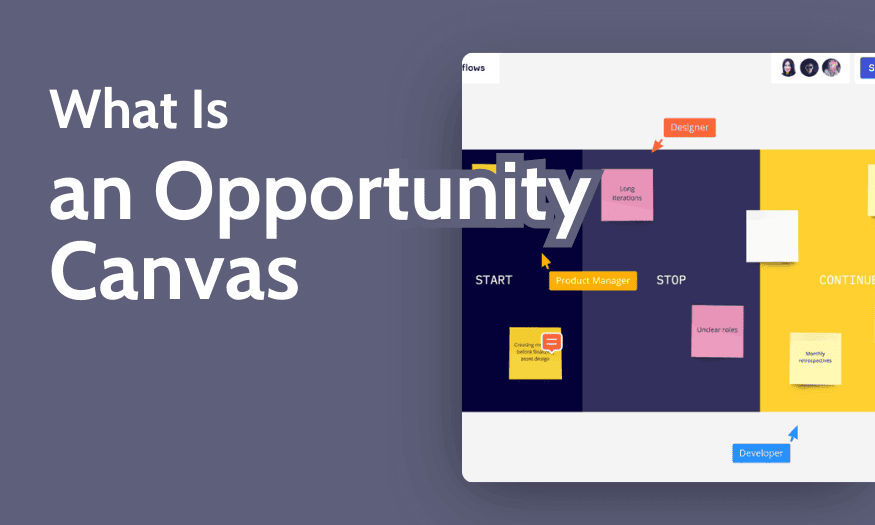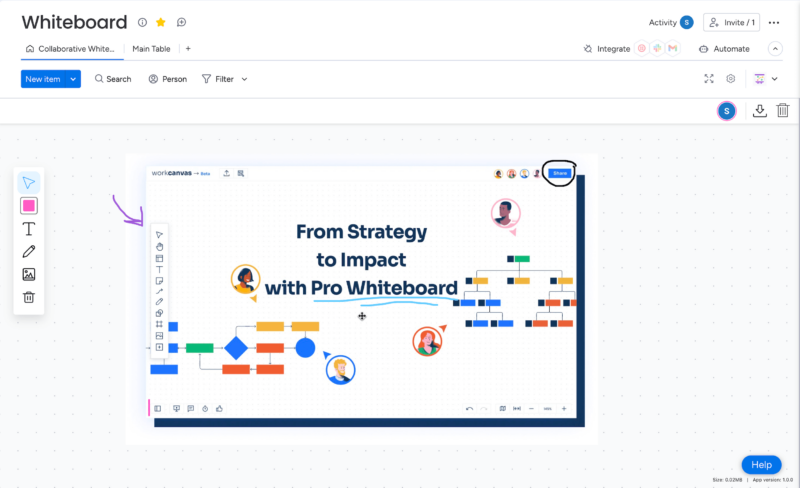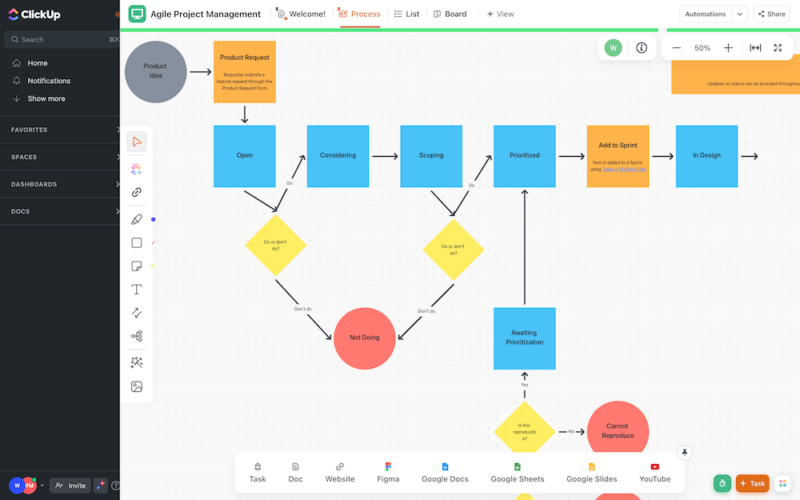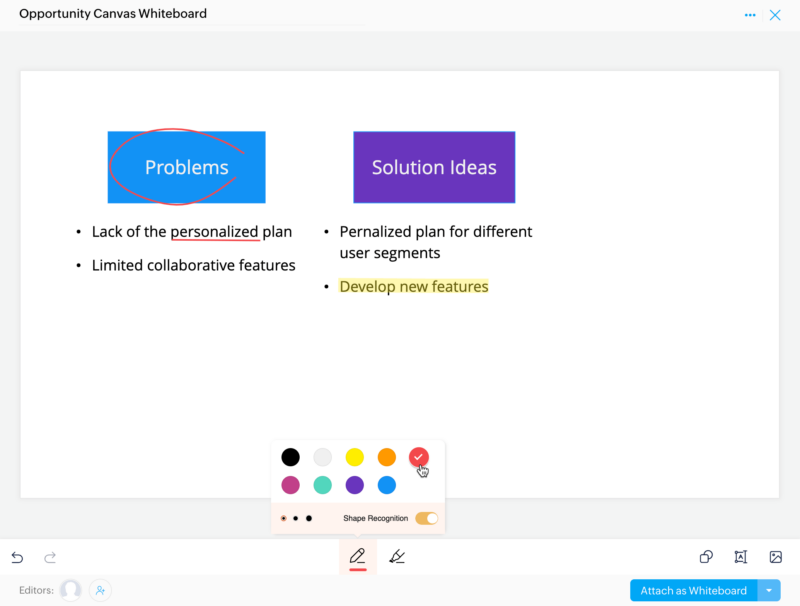
Why you can trust us
- 407 Cloud Software Products and Services Tested
- 3056 Annual Software Speed Tests
- 2400 plus Hours Usability Testing
Our team of experts thoroughly test each service, evaluating it for features, usability, security, value for money and more. Learn more about how we conduct our testing.
Key Takeaways: Opportunity Canvas Example
- The Opportunity Canvas is a visual tool used to define and evaluate a problem or opportunity, helping organizations identify customer needs, business challenges and potential solutions.
- The Opportunity Canvas consists of key elements such as target customers, problems or needs, solution ideas, challenges, budgets, adoption strategies and metrics.
- To effectively use the Opportunity Canvas, start by identifying problems or opportunities, brainstorming to gather user insights and potential solutions, planning a strategy and continuously validating assumptions.
Facts & Expert Analysis About the Meaning of Opportunity Canvas:
- Differences between tools: The Opportunity Canvas explores a specific problem or opportunity; the Business Model Canvas outlines the overall business model; and the Lean Canvas focuses on problem-solution fit and key metrics for startups.
- Structure: The Opportunity Canvas template distinguishes between the left side, which focuses on verifiable data, and the right side, which includes assumptions that require further experiments.
- Tips to use: A project team should spend 15 to 30 minutes filling out the known elements, skipping the unknown ones and noting down any assumptions on sticky notes.
Project management is crucial for any project’s success, and using the right tools and frameworks can make all the difference. One helpful tool is the Opportunity Canvas, a strategic template that helps teams identify, assess and take advantage of new business opportunities. Creating them with the best project management software can greatly improve your business.
In this article, we’ll explore the Opportunity Canvas, covering its structure and key elements. We’ll also provide step-by-step guidance on how to implement it effectively, and we’ll share downloadable Opportunity Canvas templates. Whether you’re exploring a new business idea, developing products or planning for growth, a visual canvas can be a valuable asset.
Meet the experts
Learn more about our editorial team and our research process.
What Is an Opportunity Canvas?
Created by Jeff Patton in 2016, an Opportunity Canvas is a strategic planning tool that helps businesses explore new opportunities and identify problems. It provides a visual representation of key elements like problems, target audience, potential solution ideas, challenges and user metrics.
The Opportunity Canvas is useful when you want to explore new markets, develop new features, or adapt your existing products or services. This structured approach gives you a clear understanding of your target market and user problems, and also facilitates team discussions.
Project Management
Check out our project management courses and grab a limited-time offer.
Registration available now!
Enroll Now 
monday.com provides a collaborative space for team members to brainstorm.
Purpose of an Opportunity Canvas
The Opportunity Canvas serves as a visual tool that guides businesses to examine various aspects of opportunities and problems. By filling out the Opportunity Canvas template, an opportunity analyst can determine the target markets for a new feature, identify an adoption plan for addressing customer needs, assess challenges and collect possible solution ideas.
The Opportunity Canvas has a similar structure to the Business Model Canvas and the Lean Canvas, but it focuses on identifying and evaluating new opportunities. In contrast, the Business Model Canvas focuses on comprehensive business models, while the Lean Canvas emphasizes problem-solution fit and key metrics that apply to startups.
Structure of an Opportunity Canvas
The Opportunity Canvas template clearly distinguishes between verifiable facts and experimental assumptions. The left side of the canvas focuses on data that can be verified or obtained through research, surveys or analysis, such as user insights, user problems and pain points. This establishes a solid foundation for the ideation and validation processes.
On the other hand, the right side is dedicated to any assumption or solution idea that requires further experimental validation. This includes potential solutions, strategies and user metrics. The visual separation encourages team members to collect and analyze relevant data first before proposing solutions.

ClickUp can facilitate discussions within organizations through the whiteboard feature.
Opportunity Canvas Topics
The Opportunity Canvas can help facilitate discussions and build a shared understanding of an opportunity or problem within the team. Here are some key elements to consider:
Users and Customers
Identify the specific users and customers who will benefit from your solution. Understand their demographics and behaviors to ensure your new feature meets desired outcomes.
Problems or Needs
Clearly define the problems or needs of your users that your solution aims to address. This is the foundation of your Opportunity Canvas and will guide the rest of your planning. You can store these in the product backlog.
Solutions Today
Understand the current solutions that users employ to solve their problems. This could be existing methods, tools or processes. Filling out this section will help you find new capabilities that better meet their needs.
Business Challenges
Identify the key business challenges that result from users’ problems. This helps you prioritize the most impactful problems and opportunities. Moreover, analyzing how these challenges impact your operations, revenue and growth can help you make strategic decisions.
Solution Ideas
Write the potential solutions, new features or capabilities that could solve the identified problems or meet the users’ needs. Brainstorm various ideas within the team during planning sessions, review meetings and project retrospectives.
Budget
Determine the budget required to create and launch your product. Be sure to consider development, deployment and ongoing maintenance costs. Some of the best free project management software can help you prepare budgets without creating additional costs.
Adoption Strategy
Outline a plan for how you’ll get your target users to discover, engage with and adopt new features. This could include different channels to reach your target audience, marketing campaigns to generate leads, and onboarding experiences. If you need software to develop marketing campaigns, look at our roundup of the best marketing project management software.
User Metrics
Identify metrics to measure your solution’s success from the user’s perspective, such as the number of active users, engagement, satisfaction or subscription conversion rate.
Business Impact
Fill out the key business metrics that will be impacted if your solution is successfully implemented. This could include measures such as revenue growth, cost savings, market share or competitive advantage.
What Will Users Do to Get Value?
Examine how your target users will use your solution to derive value. This could involve using the product or service in a particular way, engaging with new features or completing certain tasks.
How to Use an Opportunity Canvas?
Filling out the Opportunity Canvas is a collaborative process that should include a project owner or product manager, as well as key stakeholders. You should spend 15 to 30 minutes on the first round, where you’ll fill in the elements you know, skip the ones you don’t and use sticky notes to record any assumptions. Let’s look at the steps to use the Opportunity Canvas effectively.
- Identify problems or opportunities: Clearly define the problem you aim to solve or the opportunity you want to seize. Teams can do this by gathering relevant data and conducting market research.
- Define target customers: Identify the potential customers that your new feature will target. It’s important to consider factors like demographics and behaviors to understand their pain points and desired outcomes.
- Brainstorm solutions: List the current solutions that end users are employing and brainstorm new solutions that better address the identified problem or need.
- Determine business challenges: Assess the potential obstacles that may arise while developing and implementing your new features.
- Plan for adoption and measurement: Create a plan for how your solution will be adopted by your target customers. Teams should also determine the user and business metrics to measure success.
- Validate assumptions: Test your assumptions about the problem, your target market, your solution idea and the feasibility of your proposed solutions.
- Iterate and refine: Continuously review and refine your Opportunity Canvas based on feedback and new information during sprint reviews and sprint retrospectives.

The whiteboard feature in Zoho Projects is useful in brainstorming sessions.
Download an Opportunity Canvas Template: PDF & PPT
If you’re ready to begin using the canvas in your projects, below are several templates available for download in various formats. These templates will serve as a starting point for you to explore new opportunities.
Final Thoughts
Identifying new opportunities and problems can be a challenging task for businesses looking to grow and innovate. The Opportunity Canvas provides a structured framework to navigate this process. By completing the key elements, teams can gain a better understanding of the project’s potential and limitations, allowing them to develop an effective strategy.
To maximize the benefits of the Opportunity Canvas, it’s important to use a collaborative approach. Project managers should encourage open discussion among team members to uncover different perspectives and assumptions. Remember that the canvas is an iterative tool, and project teams should revisit and refine it as new information or feedback emerges.
Have you used the Opportunity Canvas in your project? Do you have any tips or best practices to share? What other strategic planning tools have you found useful for your project? We’d love to hear your thoughts and insights in the comments below. Thank you for reading!
FAQ: Opportunity Canvas Explained
-
The Opportunity Canvas is a one-page planning template that helps businesses explore new opportunities and identify problems. It provides a visual representation of key elements like problems, target customers, potential solution ideas, challenges and user metrics.
-
Start by identifying problems or opportunities, and then brainstorm to gather insights on customer needs and market trends. Next is collaborating with stakeholders to map out key elements, such as users and customers, challenges and potential solutions. Be sure to continuously iterate and improve the canvas based on feedback and validation.
-
The Business Canvas outlines the broader business strategy, like value propositions and revenue streams. On the other hand, the Opportunity Canvas is designed to identify and evaluate a specific problem or opportunity, delving into details such as customer pain points and potential solutions.
-
The Lean UX Canvas is a tool used in project research, design and planning to solve business problems through hypothesis and experimentation. It enables teams to work in rapid, iterative cycles. In contrast, the Opportunity Canvas focuses on identifying and assessing new opportunities or problems, including target customers, challenges and potential solutions.
The Opportunity Canvas is a one-page planning template that helps businesses explore new opportunities and identify problems. It provides a visual representation of key elements like problems, target customers, potential solution ideas, challenges and user metrics.n”}},{“@type”:”Question”,”name”:”How Do You Facilitate an Opportunity Canvas?”,”acceptedAnswer”:{“@type”:”Answer”,”text”:”
Start by identifying problems or opportunities, and then brainstorm to gather insights on customer needs and market trends. Next is collaborating with stakeholders to map out key elements, such as users and customers, challenges and potential solutions. Be sure to continuously iterate and improve the canvas based on feedback and validation.n”}},{“@type”:”Question”,”name”:”What Is the Difference Between Business Canvas and Opportunity Canvas?”,”acceptedAnswer”:{“@type”:”Answer”,”text”:”
The Business Canvas outlines the broader business strategy, like value propositions and revenue streams. On the other hand, the Opportunity Canvas is designed to identify and evaluate a specific problem or opportunity, delving into details such as customer pain points and potential solutions.n”}},{“@type”:”Question”,”name”:”What Is the Difference Between Lean UX Canvas and Opportunity Canvas?”,”acceptedAnswer”:{“@type”:”Answer”,”text”:”
The Lean UX Canvas is a tool used in project research, design and planning to solve business problems through hypothesis and experimentation. It enables teams to work in rapid, iterative cycles. In contrast, the Opportunity Canvas focuses on identifying and assessing new opportunities or problems, including target customers, challenges and potential solutions.n”}}]}]]>
Let us know if you liked the post. That’s the only way we can improve.
